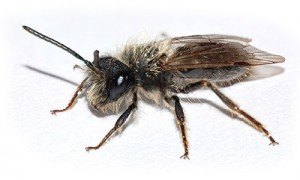Spring signals the return of many species of birds and the bees to yards and gardens. In early spring increased activity by ground nesting bees cause alarm for many people; dirt pile nests start appearing in bare patches in the lawn. They are beneficial pollinators in the garden.
Bees in the families Colletidae and Andrenidae represent the ground nesting solitary bees. They do not form hives. Solitary bees spend much of the life in the pupa stage in shallow underground tunnels or galleries; the queens live individually and raise their young. Ideal location for the nests are warm sunny grassless patches in well-drained soil; the ground should warm up quickly in the morning.
Nest or mound entrances are only a few inches across. Nests (holes) improve soil aeration holes that help in the downward movement of water and nutrients. Each spring ground bees abandon old nests, mate and build new ones. Many females may nest in the same area.
Ground bees pose little or no threat to people. Male bees comprise the majority of above-ground swarmers, and do not have a stinger. The mostly subterranean queens do have stingers, but rarely defend their nesting area. They are very docile and not likely to sting. However, if you are stung, persons with extreme sensitivity should always carry an Epipen to protect against an allergic reaction.
Ground bees are highly beneficial to your lawn and garden. To be rid of ground bees, you do not need to use pesticides. Lots of ground activity, from frequent tillage, mowing, or irrigation, will destroy nests. Simply watering the area will cause bees to move to another area.


 Posted in
Posted in 
